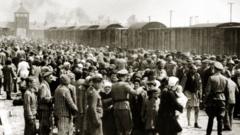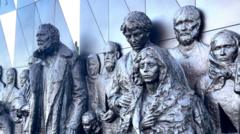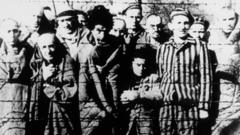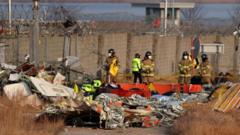On January 27, 2025, world leaders and the last remaining survivors will commemorate the liberation of Auschwitz, a symbol of Nazi atrocities, as the grim reality of the Holocaust resonates globally.
Auschwitz Liberation: Reflecting on the Dark Legacy of the Holocaust

Auschwitz Liberation: Reflecting on the Dark Legacy of the Holocaust
World leaders gather to honor the victims of Auschwitz as survivors mark the 80th anniversary of liberation.
The date marks 80 years since Soviet troops liberated Auschwitz-Birkenau, the Nazi death camp where over 1.1 million people lost their lives, predominantly Jews. As survivors, now in their 90s, gather for remembrance, it may be one of the last significant commemorations with firsthand testimonies of those who witnessed the horrors.
Auschwitz, located in occupied Poland near Oświęcim, was central to the Nazi extermination efforts during World War II. Most victims were Jews, but many Poles, Roma, and Soviet prisoners of war also perished at the camp. When the camp was liberated on January 27, 1945, only about 7,000 prisoners remained, while tens of thousands had been subjected to brutal "death marches" as Nazis retreated.
Primo Levi, an Italian prisoner, described the liberators' sense of guilt and compassion upon finding the emaciated survivors while soldier Ivan Martynushkin noted the relief in the eyes of those saved from "this hell."
The origin of the Holocaust can be traced back to the Nazis’ rise to power in 1933, which began with the systematic stripping of Jewish rights and properties. Following the invasion of Poland in 1939, Jews were forcibly deported to ghettos. By 1941, the Nazis initiated mass shootings and the use of gas chambers to facilitate their extermination goals, marking a horrifying chapter in European history.
Originally established as a Polish military barracks, Auschwitz was repurposed by the Nazis to contain political prisoners and eventually transformed into a gruesome extermination camp. A rapid expansion of the camp saw the introduction of gas chambers and crematoria by 1942, leading to the systematic murder of thousands each day.
The Nazis' procedures were meticulously organized, with victims deceived into believing they were going for showers before being gassed. The disposal of bodies was equally calculated, with remains incinerated and personal belongings meticulously sorted.
Despite the Nazis' attempts to erase evidence of their crimes, historians estimate that approximately 1.3 million individuals arrived at Auschwitz, with around 1.1 million perishing there. Among these victims, the mass extermination of Jews from Hungary in 1944 marked one of the darkest periods, as about 420,000 Jewish people were transported to the camp in just two months.
Upon liberation, the camp's remaining prisoners were marched away to other locations, leaving only a few survivors behind to bear witness to the atrocities committed. The remnants of their suffering, along with mountains of personal items, continued to tell the tragic stories of those lost.
Renowned Holocaust survivor Elie Wiesel spoke of the impact of Auschwitz, highlighting its irrevocable effect on humanity's psyche. "After Auschwitz, nothing will ever be the same," he declared, underscoring the importance of remembering the past to prevent a recurrence of such horrors in the future.
Auschwitz, located in occupied Poland near Oświęcim, was central to the Nazi extermination efforts during World War II. Most victims were Jews, but many Poles, Roma, and Soviet prisoners of war also perished at the camp. When the camp was liberated on January 27, 1945, only about 7,000 prisoners remained, while tens of thousands had been subjected to brutal "death marches" as Nazis retreated.
Primo Levi, an Italian prisoner, described the liberators' sense of guilt and compassion upon finding the emaciated survivors while soldier Ivan Martynushkin noted the relief in the eyes of those saved from "this hell."
The origin of the Holocaust can be traced back to the Nazis’ rise to power in 1933, which began with the systematic stripping of Jewish rights and properties. Following the invasion of Poland in 1939, Jews were forcibly deported to ghettos. By 1941, the Nazis initiated mass shootings and the use of gas chambers to facilitate their extermination goals, marking a horrifying chapter in European history.
Originally established as a Polish military barracks, Auschwitz was repurposed by the Nazis to contain political prisoners and eventually transformed into a gruesome extermination camp. A rapid expansion of the camp saw the introduction of gas chambers and crematoria by 1942, leading to the systematic murder of thousands each day.
The Nazis' procedures were meticulously organized, with victims deceived into believing they were going for showers before being gassed. The disposal of bodies was equally calculated, with remains incinerated and personal belongings meticulously sorted.
Despite the Nazis' attempts to erase evidence of their crimes, historians estimate that approximately 1.3 million individuals arrived at Auschwitz, with around 1.1 million perishing there. Among these victims, the mass extermination of Jews from Hungary in 1944 marked one of the darkest periods, as about 420,000 Jewish people were transported to the camp in just two months.
Upon liberation, the camp's remaining prisoners were marched away to other locations, leaving only a few survivors behind to bear witness to the atrocities committed. The remnants of their suffering, along with mountains of personal items, continued to tell the tragic stories of those lost.
Renowned Holocaust survivor Elie Wiesel spoke of the impact of Auschwitz, highlighting its irrevocable effect on humanity's psyche. "After Auschwitz, nothing will ever be the same," he declared, underscoring the importance of remembering the past to prevent a recurrence of such horrors in the future.



















